MY TIKI BAR KITCHEN -- 3
THE FOOD IS DIFFERENT HERE
Not only is shopping a bit different -- unless you do the gringo thing and buy all your stuff at Super Lake or Walmart -- but the food itself is different.
“We’ll never sell a fat yellow chicken.” Ad words from one of the big chicken mega processors in the US. When I got here and saw all the yellow chicken for sale in the stores and the markets, I was appalled -- I’m talking rubber-chicken-paint yellow. I didn’t know what to make of it. Yuck! I refused to buy any chicken for the first few weeks until I found out that the yellow is on purpose and caused by marigold-type flowers in their diet. Okay, much better -- whew! The chicken here is actually very tasty and good.

Did I mention the feet are included in a whole roasting/boiling chicken?
The veggies are fresh and local, and many appear alien -- like “from Mars” alien. Also you can get fresh organic veggies and lettuces at the organic market that are a lot less work once you get them home. The lettuce at the tianguis is fresh out of the ground complete with whatever little bugs and dirt that are in it. If I buy that, I have to cut it apart into separate leaves, wash them well, and disinfect them in the solution for 10 minutes in the sink. Then the leaves must be drained and then dried and put into baggies before being put into the fridge. A bit of work. Or you can clean and disinfect some each time you want salad.
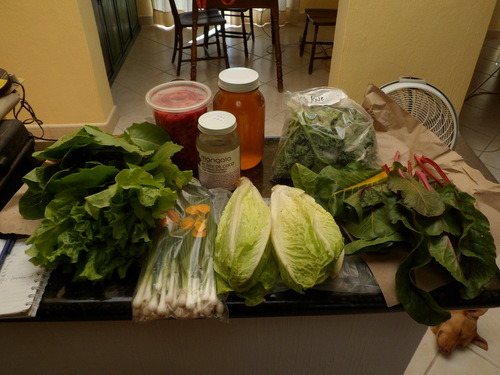
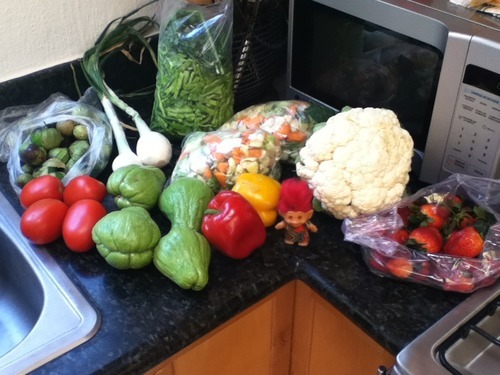
At the organic market, you can get lettuces and other salad leaves are already washed and dried and ready to use. It’s well worth the bit of extra cost over the tianguis. Or for a bit less you can buy the fresh-picked heads of all kinds of lettuces and wash and disinfect it. Calabaza squash, tomatoes, onions, avocados, and other veggies, you have to soak them in the disinfectant anyway, but that’s easy, so I just buy the tianguis offerings.
As a side note, I’m not sure why Americans don’t disinfect things like spinach and lettuce now, since there have been so many E. coli outbreaks in recent years. Water alone doesn’t kill it.
Hamburger, either at the carniceria or the grocery store, has very little fat. I used to make bigger, thicker patties because I knew they would cook down quite a bit. Here, they stay about the same size, and there’s very little fat to drain. So our first hamburger patties were HUGE. This is how much fat wasn't in the pan when they were done! 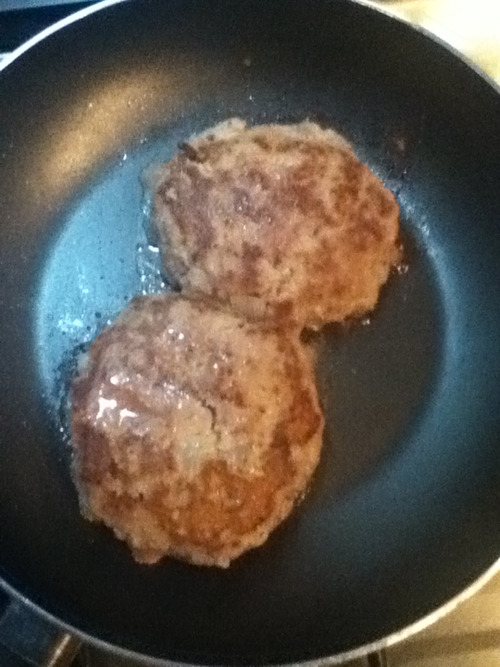
The most popular meat cuts in the States aren’t really sold down here. Unless you go to a gringo boutique carniceria, you won’t find a roast or a brisket. They have some steaks and hamburger and bistek. Bistek is very thin, like about ¼ inch or a little more. I tried cooking it fast in a cast iron skillet, but that’s just not good. We don’t buy the regular steaks since we don’t have a grill here, and I don’t like pan steak.
You can buy fresh organic eggs at the organic market, but they are really small and pretty expensive, so -- against my better judgment -- I buy the extra omega 3 eggs at Soriana grocery store. We go through almost 2 ½ dozen eggs a week, and we’re on a budget.
Eggs from the mega henhouse are very large here, bigger than extra-large back in Texas, and the yolks are very large compared to US eggs. The yolks are also usually a very bright pretty orange. I believe the orange is from the yellow flowers that the chickens are all fed here. And eggs are not refrigerated. In fact, many countries around the world keep their eggs non-refrigerated and always have. People aren’t dropping dead from salmonella either. Eggs have no need for refrigeration -- unless they have been refrigerated -- althoughit’s probably not a good idea to keep them out in the summer heat very long. In a store or home is fine.
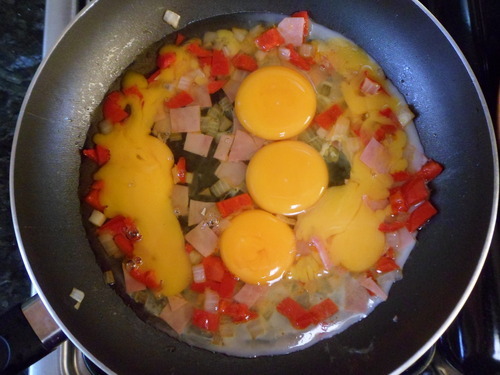
The other thing about eggs, possibly because they’re not refrigerated, is that there’s a trick to not breaking the yolks if you want to fry them sunny. You have to be very careful not to rake them with the shell as you drop them into the skillet. I am getting better at it, but success isn’t a given. Thankfully, Glenn likes his broken and/or with hard yolks anyhow, since I usually only get 3 of 4 whole. And then there's boiled eggs -- the yolks all go to one end and poke out of the whites. I wonder if it's because the whites are thinner without refrigeration.
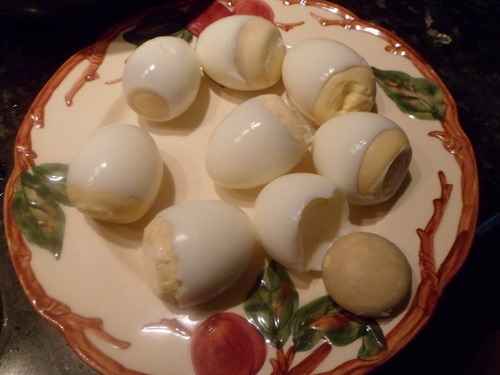
And then there’s BACON!
Bacon, the meat everyone loves to hate -- unless you’re on a low-carb diet

At the carniceria that we go to they slice it up on the spot, whatever thickness desired. We’ve also bought the FUD brand bacon at the grocery store. (Really? If you have to name it “food,” is it? It’s actually pretty good bacon.)
Both the packaged and fresh bacon take for-evver to cook. I have no idea why.
And there’s hardly any fat left behind in the pan. If you like to save and use bacon drippings, here you’re going to have to cook a LOT of bacon. The flavor is milder too -- not as addicting. (Hmmmm, what do they use to enhance the flavor in the States? Flavor addiction in all processed food is bi-i-i-ig business.)
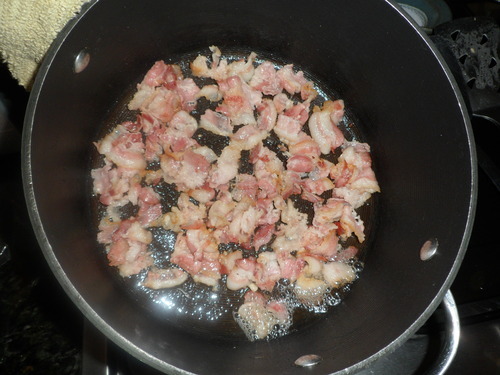 This is an entire package of bacon chopped and cooked, and no fat has been removed!
This is an entire package of bacon chopped and cooked, and no fat has been removed!
Speaking of bacon --
Carne en su jugo (meat in its juice)!
This is a wonderful Mexican stew, of sorts. The first time I saw a sign for this dish, I thought it said “meat in your juice” and pictured a frosty glass of orange with a hunk of meat in it -- YISH! Ha!
At Super Lake grocery, they had some free samples of a jarred brand and so I tried it. It was delicious. I almost bought a jar, but our housekeeper, Lorena, had said she was going to teach me that one the following week. I hired her to teach me a recipe a week while we’re here. Smartest move ever!
So...on to the recipe!
CARNE EN SU JUGO
15 small tomatillos (green tomato-like veggies with a papery outer shell and sticky skin, remove the papery shells and wash)
½ lb bacon
2 lb “bistek” -- ¼” thick skirt steak (** see note below!)
2-3 medium-large cloves of garlic
½ -- 1 serrano chili pepper
1 onion fairly finely diced
cilantro finely chopped
Add a can of beans, white or your favorite, if you choose
limones (key limes -- or regular limes) for squeezing onto your serving to taste
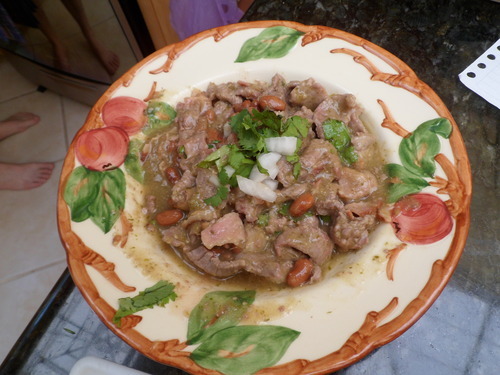
Put the tomatillos in a pan of water and boil the heck out of them for about 10-15 minutes, till they are very-ripe-soft, drain and let cool.
Chop the bacon into ¾” pieces and cook it in a good-sized pot till done but not crisp at all. Mexican bacon, it’s best to add some oil to the pan to cook it. (American bacon, you’ll probably want to drain out most of the fat after you get it cooked and you might need closer to a whole pound. Can’t have too much bacon, right?)
While the bacon cooks, chop the bistek into bite-sized pieces. When the bacon is ready, add the chopped meat or hamburger and cook it till done. Salt the meat, maybe a half teaspoon plus/minus.
While the meat is cooking, put the cooled tomatillos into a blender, add several pieces/stalks/branches (whatever you’d call them) of fresh cilantro, the 2 cloves of garlic, ½-1 serrano pepper to taste, about 1 ½ cups of water. Blend very well and long so that everything is chopped up fine (depending on your blender, you may want to chop the garlic and the serrano pepper before adding them)
When the meat is cooked, pour the blender contents into the pot. Cover and simmer/boil for 20 minutes or so. Check the flavor and adjust if needed. You may need to boil off some water or add more, depending on your preferences. It should be fairly soupy.
While it’s cooking, chop finely the onion and more cilantro. These will be added raw to each serving to taste, and as a pretty garnish. You can add a few little pieces of red tomato to make it pretty, and it adds to the flavor too. Limones are squeezed on to taste (I like it as is, without the limon, personally)
Serve in a bowl with a spoon and tortillas for sopping. Or if you make it thicker, you can spoon it into your tortillas as a wet taco.
TIP: Flour tortillas from the store are so much tastier if you “toast” them on both sides in a dry pan on the stove.
** This dish is also good with hamburger in place of the bistek, and it doesn’t have to cook as long. Just let the flavors meld.
Salud! -- to your health!
